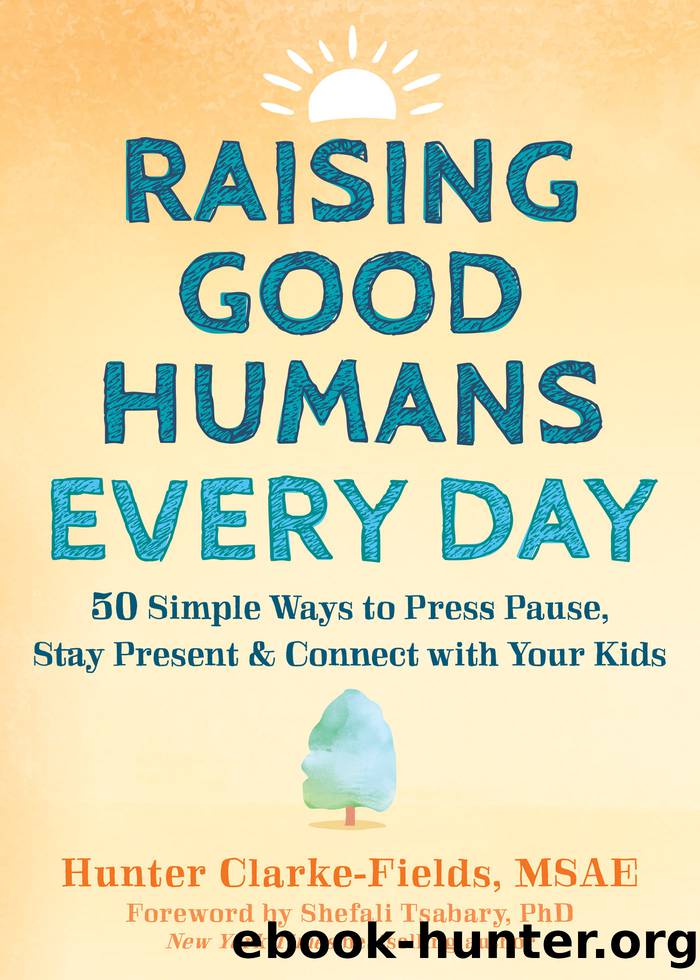Raising Good Humans Every Day by Hunter Clarke-Fields

Author:Hunter Clarke-Fields
Language: eng
Format: epub
Publisher: New Harbinger Publications
Published: 2023-06-23T18:17:00+00:00
26.
How Do I Make Them Stop?
If the ability to control emotions and behaviors isnât fully developed until early adulthood, why are we requiring preschoolers to do this and then punishing them when they canât?
âMona Delahooke
My five-year-old daughter was screaming around the house, âflyingâ a big piece of cardboard. It knocked things off the coffee table, and the noise had me gritting my teeth. This had to stop, or I was going to lose it. But Iâd just recently pledged not to use threats and punishments with her, so how the heck could I stop this? How do we hold boundaries without yelling and threatening?
When we move away from fear- and threat-based parenting, we sometimes swing to the other end of the spectrum, becoming uncertain and backing off altogether from holding boundaries with our kids. This does not work out well. Now, instead of our kids resenting us, itâs likely we resent them! Plus, kids need healthy boundaries to feel safe and cared for. Permissive parentingâallowing kids to get their way most of the timeâcan lead to unwanted outcomes for kids. Research has shown that children who grow up with parents who donât uphold appropriate behavioral expectations are more likely to be more self-centered, lack self-regulation and impulse control, and have higher rates of drug use than other children (Shapiro and White 2014).
Boundaries are healthy and necessary even if you want to move from an authoritarian paradigm to a more democratic way of doing things. Think of yourself as the wise, benevolent leader setting rules and routines for mealtimes, bedtime, homework time, chores, screen time, and more. Let kids be kidsâexpecting them to be immature and unskillfulâand give them limits to keep them healthy and safe and to honor our own human needs. For both the parentsâ sake and the childâs, itâs important to decide what those limits are ahead of time. Then when thereâs opportunity for freedom, we can allow it.
In our home, we had three overarching rules: (1) take care of ourselves, (2) take care of each other, and (3) take care of our home. Smaller rules and norms stem from these and help provide a sense of teamwork among the familyâwe do things this way, not that way. We put away our toys when weâre done playing. We turn off the lights when we leave a room.
Running around and knocking things down with a big piece of cardboard was not taking care of our home (or helping me and my sanity). So how to deal with this? I had a big shift to realizing that I can hold these boundaries without being scary, harsh, and disrespectful. I could be firm and kind. Instead of yelling, I can catch my daughter and say âWhoa! Hold on a sec, honey. That cardboard is knocking things over,â while I gently take it from her hand. I offer her an opportunity to run outside with the cardboard. She learns a better way to be in the world, and our relationship is not damaged.
Download
This site does not store any files on its server. We only index and link to content provided by other sites. Please contact the content providers to delete copyright contents if any and email us, we'll remove relevant links or contents immediately.
Should I Stay or Should I Go? by Ramani Durvasula(6802)
The Lost Art of Listening by Michael P. Nichols(6485)
The Rosie Project by Graeme Simsion(5202)
We Need to Talk by Celeste Headlee(4882)
Beartown by Fredrik Backman(4437)
Suicide Notes by Michael Thomas Ford(4279)
Hunger by Roxane Gay(4237)
Ego Is the Enemy by Ryan Holiday(4005)
I Love You But I Don't Trust You by Mira Kirshenbaum(3236)
Mummy Knew by Lisa James(3176)
Crazy Is My Superpower by A.J. Mendez Brooks(2869)
Girl, Wash Your Face by Rachel Hollis(2830)
The Complete Idiot's Guide to Coping With Difficult People by Arlene Uhl(2825)
Toxic Parents by Susan Forward(2814)
Not a Diet Book by James Smith(2744)
The Hard Questions by Susan Piver(2557)
Name Book, The: Over 10,000 Names--Their Meanings, Origins, and Spiritual Significance by Astoria Dorothy(2498)
The Gaslight Effect by Dr. Robin Stern(2357)
The Social Psychology of Inequality by Unknown(2318)
